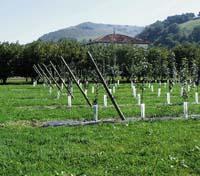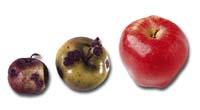Hat of fire and grained, enemy of the apple trees

Fire and granulation are two of the three most serious diseases that affect apple trees. The red fire is produced by a bacterium (Erwinia amylovora) that affects all organs of the plant. The first symptom is that the buds appear as if they were burned. If the fruit tree is very sensitive, it can also die. Granulation, on the other hand, is due to a fungus ( Venturia inaequalis ) which only affects leaves and fruits. This facilitates the control of the disease. Due to the fungus, small apples of bad appearance are formed, and dark spots appear on the leaves.
In 1996 a red fire focus was inaugurated in Spain. Governments took steps to eradicate the threat because they feared that the disease would spread to pears and other species. One of the decisions taken was the implementation of a research project between the Universities of Girona and Valencia and the Public University of Navarra, in order to clarify the resistance to the pathogen, the lack of sensitivity and the variety of apple trees. After a few years, granulation was also introduced, as it is one of the diseases that most affects apple trees.
In this context, the Venezuelan biologist has analyzed 253 apple varieties in Spain, in order to find out if they are resistant to red fire and to bites and varieties. The study was carried out in Doneztebe/Santesteban, where the Technical Institute of Agrarian Management has its experimental land with all these varieties of apple. In addition, it has identified variants of the fungus Venturia inaequalis.
The research has a great practical interest. And, after knowing well the red fire and the granulation and varieties that suffer, these varieties can be cultivated to combat the disease. In the case of granulation, this method is preferable to the use of fungicides. In fact, if the plant is very sensitive it is necessary to perform 15 treatments per year. This damages the environment and is expensive. In addition, the continued use of insecticides allows the formation of strains that develop resistance.
By inoculation

The researcher has analyzed these 253 varieties in a differentiated way. First, to rule out the largest number of inadequate varieties, it has focused on leaves. Thus, according to the spots of the leaves, it has directly discarded the varieties that present a high sensitivity to both diseases. Subsequently, he has deepened the study of the varieties that have passed through the test of the leaves, through the inoculation of the shoots. The inoculation technique consists of the controlled introduction of infectious disease germs to an organism to study its effect.
The two-step research has its reason. In fact, sensitivity tests require many inoculations, and many varieties cannot be studied in a short time. The rapid essay on leaves was overcome by 103 of the initial varieties. Some of these varieties showed a low sensitivity to the disease, while others were selected by the organoleptic properties of the apple: smell, flavor or appearance of the apple.
After the inoculation of the shoots, these 103 varieties were classified into three groups according to their sensitivity, while 48 showed little sensitivity to red fire. Subsequently, these 48 varieties resistant to red fire were introduced both diseases at a time. Of these 48, 38 showed little sensitivity to granulation, of which 12 suffered well both diseases. In short, of the 253 initial varieties, 12 are resistant to both diseases.
The second conclusion of the study is that in the north of Spain 7 variants of the fungus Venturia inaequalis have been identified. The 12 varieties of apple that have passed the inoculation test present at least resistance to one variant, while the 4 varieties support all variants.
Looking to the future

Alejandro Martínez is the first such research carried out in the State, although similar studies have been conducted in Europe and the United States. In addition, evaluations of red fire and granulation have been carried out in field, this being the first research carried out in laboratory.
In the future, it is interesting to know which variety of apple trees suffer well one or another disease to produce these varieties. However, the variety that suffers from a disease may not be adequate for the market due to its organoleptic properties. In this case, one of the alternatives is the genetic combination of two varieties. This is what is being done at the Technical Institute of Agrarian Management to find a variety for cider production. Although for the moment the project is in the study phase, it can have good results in the long term.





